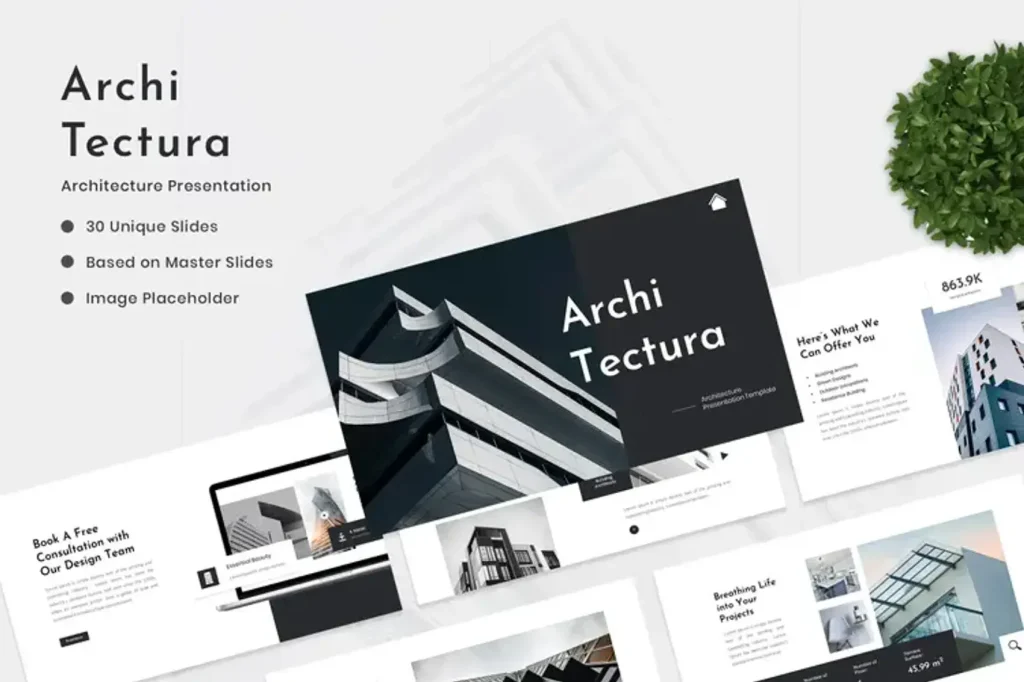
Architecture Project Presentation
Are you asking how to make your architecture project presentation stunning and add life to your idea?
Aiming to show your technical details along with a creative vision?
Here, you will find the best practical guide to fulfill your goal.
We will discuss the essential elements that help you build your presentation with successful and supportive tips that take your presentation to an advanced level, easily deliver your vision to your clients, and convince them of your project.
Follow us to make your presentation a window to new opportunities in the world of architecture.
What to talk about in an Architecture Project Presentation?
An architecture project Presentation is a structured showcase of your architectural design by which you can communicate the concept, design process, and your vision behind a project.

You can use various forms such as slideshows, drawings, models, digital renderings, and 3D walkthroughs.
To help make your presentation visually impressive and professionally structured, you may want to explore the Architectura Architecture Google Slides Template. This template is designed specifically for architecture presentations and includes modern, clean layouts that support visual storytelling effectively.
You have to present your vision in a clear, visually comfortable, understandable, and persuasive way to build a connection with your audience.
In the following lines, we will discuss the exact components that are discussed in a successful architecture project presentation.
How do you write an architecture project?
The architecture project proposal is a detailed document that covers all aspects of the project, such as vision, design, timeline, and costs.
Its main purpose is to gain the trust of your clients, persuade them, set defined expectations, and turn ideas into action plans that help you inspire confidence and win approval.
The architecture project should include:
- Title slide
- Cover letter
- Executive summary
- Project overview
- Proposed design solution
- Scope of work
- Timeline
- Pricing
- Team
- Past projects
- Terms and Conditions
- E-signature
- Contact slide
- Appendices slide
Now, let’s discuss each item separately.
- Title slide
It is the slide that attracts the attention of your audience. You can add:
- Your logo
- Proposal title
- Recipient’s name and details
Keep it simple and start with a friendly connection.
- Cover letter
It is a short slide with personal notes that allows you to really connect with your audience.
Make them feel as if they are part of your project and show your excitement for solving challenges.
- Executive summary
It is a quick, highly impactful summary about your design and shows why you are the best choice.
Focus on the client’s needs, challenges, and goals, and leave in their minds that you are the partner they are looking for.
- Project overview
Here, you prove that you identified the needs and have a detailed action plan to fulfil them while facing any challenges.
Highlight the basic elements:
- Why is your project unique
- What hurdles do you anticipate
- How do you tackle them?
Make your audience reassured that you’re
Having a defined plan to show.
- Scope of work
It is the backbone of any project, this section discusses technical and practical aspects.
It discusses the execution of the project and breaks down phases and tasks to ensure the delivery of information to the client smoothly.
A well-prepared project scope transforms ideas into action.
It makes clients comfortable that there’s a solid plan and reassures them that anything is controllable and nothing important will be missed.
- Timeline
A clear timeline builds trust and gives them a clear vision of what will be done.
However, many unintended delays may occur, like signing approvals, supply chain delays, or others.
Therefore, depends on a risk diffusion strategy that may include alternative options, built-in buffers to face unexpected incidents.
- Pricing
Avoid being confused by breaking the process into steps or phases such as concept development, documentation, design refinement, and construction oversight.
It is a good option to offer various pricing packages or payment options if possible to add flexibility and comfort to the client.
Moreover, you can shed light on the factors that may affect the budget, such as site challenges, material options, and others.
Link each element to a real value to transform an overwhelming pricing slide into an understandable and reasonable roadmap.
- Team
A friendly and comforting idea is to mention the people participating in the project and highlight their qualifications and experience that match the clients’ needs to build trust and confidence, especially if you mentioned their previous successful projects.
- Past projects
It is your chance to fascinate your clients and leave an excellent first impression on your audience.
Organize your previous projects into clickable tabs to allow clients to reach them easily and find the ones related to them.
Each tab includes detailed descriptions, photos, or videos.
You can also add 3D mideast or virtual reality walkthroughs for an immersive, unforgettable experience.
- Terms and Conditions
Setting clear terms and conditions is a critical step for professional and smooth collaboration, You can do this through:
- Define your payment strategy (upfront fees, milestone-based payments, phased billing)
- Mention the due dates and penalties in case of being late.
- Include protective statements for sensitive information or proprietary design details to protect both sides.
- Define responsibilities clearly
- E-signature
It is an important step to speed up the process and encourage clients to take action.
It is also modern, professional, and shows your readiness to start without delay.
- Contact slide
Don’t forget to leave all your possible contacts with a clear format, add your phone numbers, email address, and others.
How do you structure a project presentation?

There are some standard criteria that must be covered in any project presentation, discussing all aspects through slides, speech, and discussion.
In this section, we will discuss the crucial aspects to be covered in the ideal architecture project presentation.
- Catching Introduction
First, you must welcome your audience and give them an overall idea of what is coming.
Show them that your project suits the company’s vision, and it will be beneficial for their strategy.
- Project Overview
Go deeper through your presentation with a project overview, You can do this by adding an overview slide that represents the introduction to your presentation and what’s inside.
This overview slide includes:
- A brief introduction with a summarized background about your project.
- A brief explanation of your objectives and the expected goals.
- An estimated start and end date of the project.
- Model of the project process
This presents the project phase, starting from inspection to completion.
The project process model is a combination of various knowledge areas that represent the guide along the project cycle, It is also important to understand the systematic processes and the estimated time they will take.
- The Resources
Any project requires resources that will make the overall expenses and define the final budget.
Therefore, you will need to break down the project’s budget to show the high-level resources.
- The project roadmap
Planning and time management are essential for the project team to estimate the required time to complete the project’s scope.
The plan is built by using the project process model, project scope, and resources.
You can construct your roadmap using visuals and layouts from illustrative to structured formats.
In case of an updated project presentation, mark the position of the project on the roadmap at this moment.
- Activities plan
The road map is broken down into action plans that list activities, their resources, their duration, and the relationship between each activity.
resent your project’s activities plan with:
- Gantt Chart: to show the activities to complete, the required time, and who is responsible for them.
- Costs Report: the cost of the activities’ execution.
You can use some slides to illustrate specific sections in the Gantt chart for discussion of activities and milestones.
- Risk assessment
Any project has its own risks that need to be identified, assessed, evaluated, and mitigated.
Design a risk matrix and incorporate it in your architecture project presentation.
Show your abilities to control the risks and prevent them, and remember that risk management is a critical component of any project management, and clients will always be concerned about it.
- Quality control
Positive project outcomes and continuous success require controlling the quality of all aspects of the project, this is quality control ot quality assurance.
Some quality assurance techniques include statistical process control (SPC), Six Sigma, ISO 9000, and Total Quality Management (TQM).
- Project Monitoring and Execution
Through this slide, discuss how you will monitor the activities and how to measure the outcomes.
Also, show how you can control deviations in the project.
Make a comparison to visualize the completed percentage vs. the planned progress and the budget consumption vs. the planned one.
- The Team
It is important that everyone in the project knows the other parties and their duties and responsibilities
Insert a stakeholder map to illustrate the management team, the stakeholders, the sponsors,, and the implementation team.
How do you create an architecture project concept?
The project concept aims to set guidelines and provide a framework for the design and the final structure.
The concept is generated from one or more factors in the design.
Architects do research, documenting and understanding the site’s existing conditions, then analyze them to make a decisions in connections, relationships at many scales.
The architecture design concept sheets consist of:
- Site Analysis
- Conceptual Sketches
- Floor Plans
- Elevations and sections
- Material Selection
- 3D Renderings
- Annotations and Explanations
- Mood boards
Do architects have to give Presentations?
Architects are the ideal people to give a successful architecture project presentation, they will deliver their concepts and ideas I the perfect way.
Some presentation skills must be fulfilled, like public speaking, ability to control the discussions, eye contact, storytelling, and others.
If you prefer using Microsoft PowerPoint, check out the Architectura Architecture PowerPoint Template. It offers a polished set of slides tailored for architectural portfolios, making it easier to present your ideas with clarity and confidence.
How to present an architectural project?
An architecture project presentation is not about showing designs, however, it is about a way to convince audiences of the project value by telling a story and evoking their emotions.
A successful architecture project presentation must explain the presentation structure, contain illustrations, and have attractive visuals.
How should I introduce my project Presentation

The architecture project presentation must contain graphics with text to clearly deliver the idea and the essential aspects of your design scheme.
Add professional and essential drawings that boost your vision and avoid any unsupported work or information.
Always remember that quality is better than quantity, to avoid boredom and confusion
Here are some practical tips that ensure the success of your presentation.
- Know your clients and audience
It is important to know your target client category and know their interests in order to tailor your presentation to be client-focused, to enhance functionality, and aesthetic appeal.
- Keep it engaging and simple
You must maintain simplicity, along with showing every detail of your project in an engaging environment.
Focus on the key elements you want to deliver and avoid overwhelming your audience with too many visuals or jargons that is not easily understood.
- Continuous practice
The way you present is important, just as what you present.
Practice your language and speaking skills, start smoothly with maintaining eye contact, and be ready for questions.
These presentation skills are useful to attract your audience’s attention and increase the value of your presentation.
- Make it a story
Storytelling is an important skill that helps you deliver your information without boredom and makes it memorable.
It takes your audience from concept to completion in engaging steps.
Start with an interesting introduction to your project, then present your design and the possible challenges, and how your design will overcome these challenges.
- Use technology
Use digital tools like virtual reality or 3D tools to add life to your project and help the audience to imagine it.
Let them be immersed in your presentation with different senses to encourage them to connect with your project.
- End with a call to action
A universal rule for any successful presentation is to determine the next steps for your client in order not to get lost and know exactly what to do next.
You can take the next step by scheduling the next meeting, signing a contract, etc.
How do you present a project confidently?
The first impression lasts, so it is critical to give your architecture project presentation with the best copy of yourself, which helps reassure the audience to reassure you.
- Dress well, professional and comfortable clothes
- Prepare well
- Continuous practice
- Begin with the presentation structure
- Know your audience
- Maintain eye contact
- Talk with a friendly tone
- Be flexible with any counter-opinion
- Take care of your body language
- Use a simple background
- Avoid packing your architecture project presentation with information
- Use comfortable colours and avoid using different fonts; rather, use various sizes of the same font. The recommended font is serif type, including Helvetica, Sans Serif, and Century Gothic.
- Don’t forget to wrap up your presentation for the summary with a related quote or theory.
If you are a college student, discover the Coledia- College Education PowerPoint Presentation.
Conclusion
An architecture project presentation is not just about sharing a design; it is also an opportunity to communicate a vision.
And remember, a successful project presentation is not only about how you present your ideas, but also about the ideas themselves.
Your passion, confidence, focus on core elements, use of appropriate visuals, and clarity can be just as persuasive as your design.
Publication Date
June 24, 2025
Category
Presentation
Reading Time
11 Min
Author Name
Reem Kamal